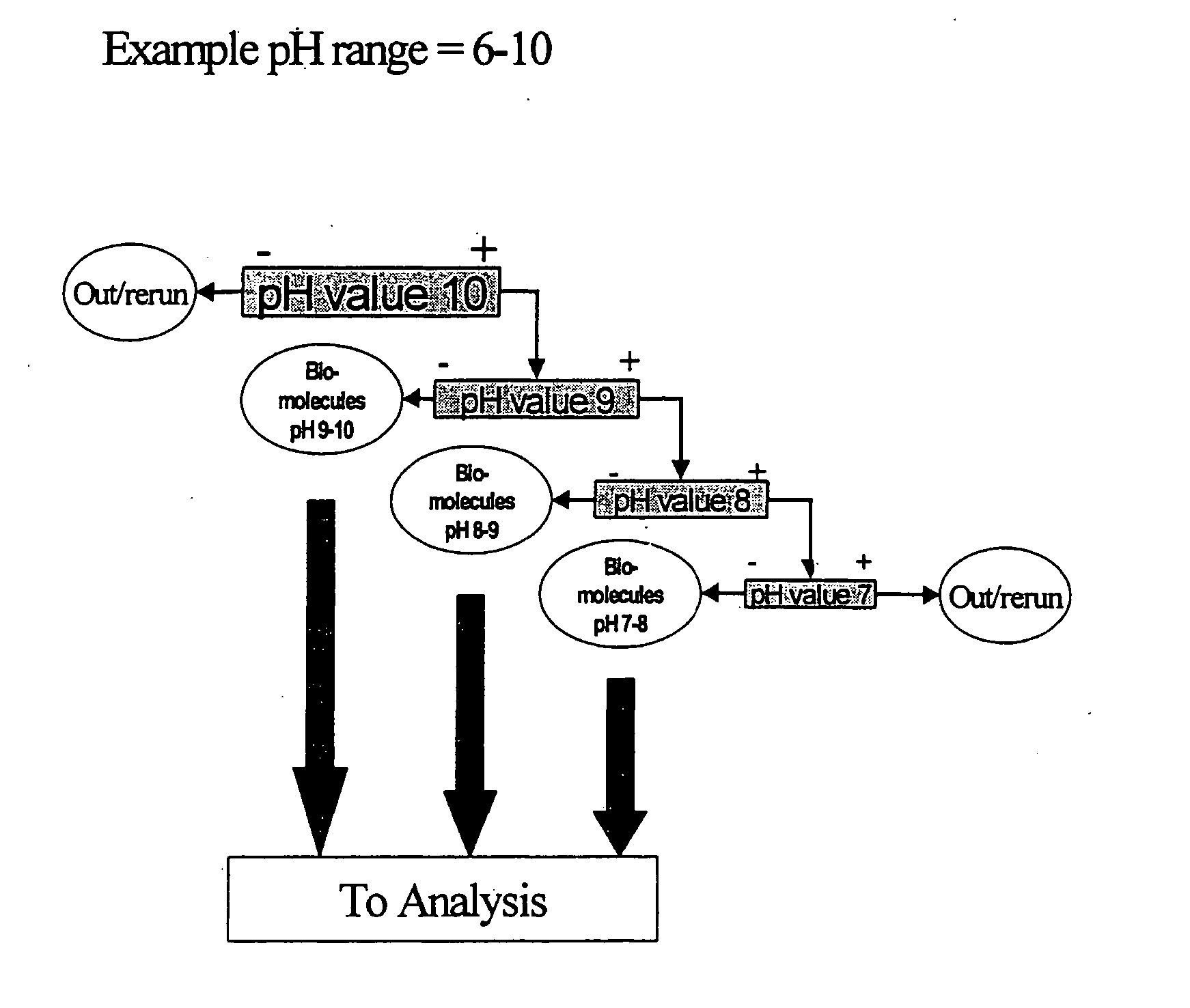Method of separating biocomponents contained in a liquid, a separating system and a separating unit
a biocomponent and liquid separation technology, applied in the direction of liquid/fluent solid measurement, fluid pressure measurement, peptides, etc., can solve the problems of time and labor-intensive traditional gel electrophoresis techniques, inability to resolve and inability to solve all proteins present in single ief gel. , to achieve the effect of reducing the bonding of non-specific molecules or components
- Summary
- Abstract
- Description
- Claims
- Application Information
AI Technical Summary
Benefits of technology
Problems solved by technology
Method used
Image
Examples
example 1
Manufacturing a Separating Path with a pH-Gradient for Separation of Proteins
[0210] 1 g Dodecylamine in 100 ml acetone is mixed with 1% UV curing agent (loctite 3201).
[0211] 1 g of Maleic acid in 100 ml acetone is mixed with 1% UV curing agent (loctite 3201).
[0212] The solutions are placed in the dosing apparatus (a Hawad syringe pump,) that can be controlled. The dosing from each of the syringes can be varied with time. The two separate flows of material are merged together in a small static mixture, then dosed into the substrate though a needle.
[0213] The 30 mm wide VK1100 substrate for the pH-gradient is then wetted with a mixture of acid, base and UV adhesive soluted in the solvent as the substrate at a constant speed passes the premixed mixture flowing out of the needle. The substrate with the solution added then passes an evaporation chamber for evaporation of the acetone and then an UV source for curing. The substrate is re-spooled on a reel pulled by a 24 V DC motor.
[02...
example 2
Manufacturing a Separating Path with a pH-Gradient for Separation of Proteins
[0217] 1 g Hisdidine (amino acid) base in 100 ml water is mixed with 1% UV curing agent (loctite 3201).
[0218] 1 g Lysine (amino acid) acid in 100 ml water is mixed with 1% UV curing agent (loctite 3201).
[0219] The solutions are placed in the dosing apparatus (a Hawad syringe pump) that can be controlled. The dosing from each of the syringes can be varied with time. The two separate flows of material are merged together in a small static mixture, then dosed into the substrate though a needle.
[0220] The 30 mm wide VK1100 substrate for the pH-gradient is then wetted with a mixture of premixed amino acid and amino acid base and adhesive soluted in the solvent as the substrate at a constant speed flows out of the needle. The substrate with the solution added then passes an evaporation chamber causing the water to evaporate and then an UV source for curing. The substrate is re-spooled on a reel pulled by a 24...
example 3
Manufacturing a Separating Path with a pH-Gradient for Separation of Proteins
[0223] 0.1 mol Maleic acid in 100 ml acetone is mixed with 0.01% UV curing agent (Irgacure 369 from Cibasc).
[0224] 0.1 mol Allylamine in 100 ml acetone is mixed with 0.01% UV curing agent (Irgacure 369 from Cibasc).
[0225] The solutions are placed in the dosing apparatus (a Haward syringe pump) that can be controlled. The dosing from each of the syringes can be varied with time. The two separate flows of material are merged together in a small static mixture, then dosed into the substrate though a needle.
[0226] In order to obtain a good adhesion of the acid and base to the substrate, it is pre-treated with e.g. hexene in as plasma process.
[0227] The 30 mm wide VK1100 substrate for the pH-gradient is then wetted with a mixture of acids, bases and adhesives soluted in the acetone as the substrate at a constant speed passes the premixed acid and base flowing out of the needle. The substrate with the soluti...
PUM
| Property | Measurement | Unit |
|---|---|---|
| Fraction | aaaaa | aaaaa |
| Fraction | aaaaa | aaaaa |
| Electric field strength | aaaaa | aaaaa |
Abstract
Description
Claims
Application Information
 Login to View More
Login to View More - R&D
- Intellectual Property
- Life Sciences
- Materials
- Tech Scout
- Unparalleled Data Quality
- Higher Quality Content
- 60% Fewer Hallucinations
Browse by: Latest US Patents, China's latest patents, Technical Efficacy Thesaurus, Application Domain, Technology Topic, Popular Technical Reports.
© 2025 PatSnap. All rights reserved.Legal|Privacy policy|Modern Slavery Act Transparency Statement|Sitemap|About US| Contact US: help@patsnap.com



